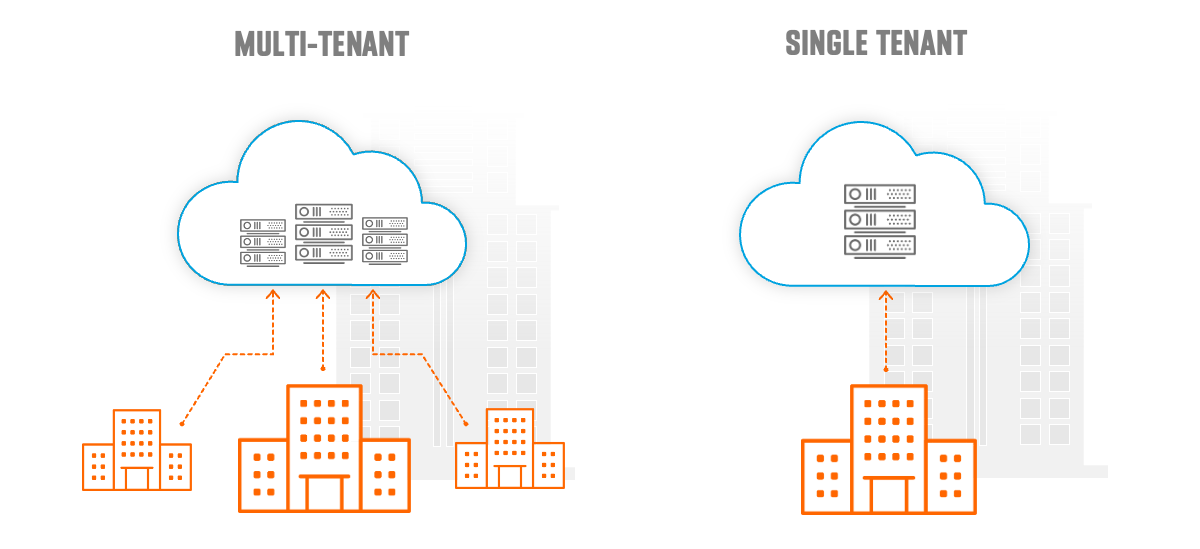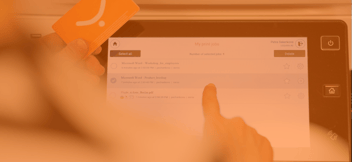What is a multi tenant cloud application? In a one-page print job, multi-tenant cloud architecture is the foundation of most SaaS offerings. It describes a single cloud instance that is designed to enable multiple tenants to share their cloud architecture and its underlying resources.
Today, more and more organizations are employing a cloud-first strategy by moving their operations to the cloud. Research shows that 67% of enterprise workload has transitioned to the cloud and 40% of companies use a cloud-native-first strategy. And according to Gartner, 95% of businesses will leverage the cloud by 2025. Why is that?
In a cloud environment, businesses can achieve cost-savings, enjoy automated processes, future-proof their IT systems, scale up or down depending on needs and growth, safeguard data, and take advantage of always-on availability. With SaaS-powered solutions, you can even let go of system administration and make life easier for your IT team.
📖 Read on → Why Move to the Cloud? 11 Reasons to Embrace the Cloud
And when we talk about Software-as-a-Service (SaaS) or cloud solutions, the multi tenant architecture conversation naturally comes into play. But what is Multi tenancy cloud really?
A multi-tenant cloud is a type of software architecture that welcomes multiple users (or tenants) into one cloud instance. Users share the same cloud resource (application) while keeping their data separate and each tenant is able to access only their allotment in the cloud, remaining invisible to other tenants.
In this article, we explore the benefits of opting for a multi tenant SaaS print solution and break down the differences between multi tenant vs single tenant software arrangements.
What is A Multi-Tenant Cloud Application?
First off, the ‘cloud’ represents various services and software that run on the internet. More on that and how it ties to your print infrastructure here → What is Cloud Print?
Instead of running locally on an individual’s computer, tasks performed via the cloud do not take up the computing power of an individual’s or business’ computers.
Cloud computing enables the delivery of computing services, including the following, over the internet:
- Analytics
- Intelligence
- Servers
- Storage
- Databases
- Networking
- Software
Businesses are no longer required to have on-site data centers or server facilities. Third-party providers, such as IT infrastructure companies, can supply cloud solutions that are appropriate for clients’ needs.
In software architecture, 'tenants' is user groups. Different tenancy architectures address how service providers provide users access to their software. For example, with multi tenant SaaS apps, tenants buy a “slice” of the cloud architecture rather than paying for their own private cloud.
📖 Read on → How SaaS Printing Helps Transform IT
Multi-tenancy is all about public cloud deployment with an ecosystem shared by multiple tenants–where each tenant has their own space allocations. They can then use this to store apps, data, and other requirements. Despite sharing resources, tenants are unaware of each other, and their data is kept isolated (tenant can only access their own separate database).
In a multi tenant environment, all customers share the same resource, operating environment, hardware, and storage mechanism, each with their own isolated space.
According to Flexera’s 2023 State of the Cloud report, 96% of companies leverage public cloud solutions, i.e., adopted multitenant applications.
Multi-Tenant vs Single-Tenant Cloud
What’s the difference between a single-tenant and multi-tenant environment? Essentially, a single-tenant cloud (i.e., reserved hosting) has only one client whereas a multi-tenant cloud (i.e., shared hosting) serves multiple clients. In a nutshell, here’s how the two cloud architectures differ:
- Multi-Tenant Cloud (Shared hosting): Multi-tenancy allows multiple clients to share the same cloud resource. In effect, the clients’ apps and websites are hosted alongside each other. Multi-cloud services are typically public cloud arrangements. This type of arrangement opens up the application to multiple tenants, while separating their data and access across separate databases.
- Single-Tenant Cloud (Reserved hosting): Single tenancy offers clients a dedicated resource specifically for one client’s databases, software architecture, and other elements. Typically, businesses that use a third-party cloud service or deploy their services in a private cloud fall under a single-tenant arrangement. This type of arrangement makes both applications and databases separate.

To clearly understand how the hosting options deviate from each other, here are two ways to think of them:
- The Bank or Under the Bed: In this example, the bank is the analogy for a multi-tenant cloud service. Multiple people can store their money in the same bank, and their assets are completely separate even though they are stored in the same place. However, keeping your money in your wallet or hiding it under the mattress represents a single tenant instance where the hardware (the bed or wallet) and the resources (the money) are exclusively dedicated to one tenant.
- Apartment or House: Here, the multi tenant cloud is likened to an apartment building where residents have keys to their separate apartments but share the infrastructure that delivers water and power. The house serves as a single tenant architecture.
For context, there are also hybrid cloud offerings that allow organizations to combine hosting arrangements based on their needs. Resources are allocated across single-tenant and multi-tenant cloud platforms, allowing organizations a greater degree of flexibility depending on their needs.
What Are the Benefits of a Multi-Tenant Cloud?
Naturally, both cloud environments have their own set of advantages. Very briefly, single tenancy offers clients the following benefits:
- Reliability
- Dedicated cloud environment
- Easier and more tailor-made customization
Multi-tenancy, on the other hand, comes with several benefits that are great for businesses looking to optimize their resources further:
1. Multi-Tenant SaaS Means Lower Costs
Multi-tenant cloud services are more cost-effective than single-tenant ones because the cost of ownership and maintenance is shared across multiple users. This is something that a lot of organizations benefit from as the savings can be significant over time.
Given that multi-tenancy architecture is typically found in public cloud arrangements, chances are that the costs are also subscription-based (predictable monthly or annual subscription price based on number of licenses, users, usage, or data volumes). The multi tenant SaaS environment allows tenants to only pay for the licenses they need.
2. Sharing Equals Resource Efficiency
Multi-tenancy architecture allows for efficient usage of compute and hardware resources. Tenants share these computing resources, which allows for efficient use. Multi-tenancies increase resource utilization efficiency, ensuring no waste of resources and avoiding unnecessary costs.
3. SaaS Platforms Are Easy to Set Up and Scale
SaaS platforms that offer multi-tenant cloud services typically have large numbers of clients and are experts at providing support and making sure that cloud adoption goes smoothly for each client. This is also true from a user group perspective.
Multi-tenant simplifies onboarding–It doesn't matter if there are 10,000 users from one company or 10 users from 1,000 companies. You only need to set up one single instance of a software application, which in turn will be able to serve everyone in your user group, however many.
Where other types of architecture may suffer outages or downtime based on demand, multi tenant SaaS architecture can easily scale and reallocate resources when necessary.
4. You’ll Face Less Maintenance Work
Multi-tenancies are easier to maintain because updates are typically handled by the SaaS company. Since environments are similar for all clients, providers can provide an optimal onboarding and maintenance process for each one. A single software instance is much easier to maintain, secure, and optimize over time.

Why Multi-Tenancy Fast Tracks Evolution
When hundreds (or even thousands) of businesses are using the same operational infrastructure, all of them benefit through the ways in which they’re challenging and improving that shared cloud infrastructure.
New security and compliance features requested by one customer will be implemented on the platform seamlessly, for all customers, at no additional cost. And, thanks to cloud architecture — with zero downtime. If a customer identifies a security issue, that issue is not only eliminated for the specific customer; it’s fixed for all customers at once.
All the while, platform providers gain insight into their customers’ businesses, pain points, and needs. This gives solution providers the ability to compare data with their other customers and draw powerful conclusions on the product roadmap and evolution.
Multi tenancy is also one of the key differences between a legacy application that ‘moved to the cloud’ (Cloud-enabled) and one that was ‘born in the cloud’ (Cloud-native). Those that moved to the cloud are less likely to evolve than those born in the cloud. Applications born in the cloud will likely continue to evolve with the cloud, alongside the wealth of possibilities it creates.
📖 Read on → Cloud-Native or Cloud-Enabled? Learn the Difference Here
A word of caution. When you’re ready to choose a print-infrastructure solution for your cloud-first strategy, validate your supplier’s cloud credentials first. Here are a few questions to ask them:
- Was this solution built for the cloud or has it been moved to the cloud?
- How do you scale the server resources associated with my business peaks? (You want to hear its elastic scalability – instant, automated, and scaled to suit your business needs).
- How do you deliver security or compliance updates? What’s my downtime impact? (Ideally, you want to hear that there’s zero downtime).
- How long will it take to set up new sites/devices/services? (They should be capable of near-instant provisioning).
Essentially, you want your supplier to have a secure infrastructure with superior technology. This will ensure that they will be a reliable provider for years to come and will not put your organization under any kind of risk.
FAQs on Multi-Tenancy Cloud
Q1) Are Multi-Tenant Cloud Architectures Secure?
It’s not uncommon to consider security in a multi tenant application distorted. This is because a breach in one tenant’s database could impair other tenants' privacy or data within the shared environment.
That said, even more importantly, solution providers apply a proactive approach to security, conducting frequent penetration tests and vulnerability scans to ensure risks are mitigated at all times.
One benefit of SaaS solutions is that providers deliver frequent updates (monthly in our case) with anything from security patches to preemptive security enhancements being delivered to every tenant for an immediate upgrade.
Q2) Is Data Kept Separate in a Multi-Tenant Application?
Multi-tenancy architecture can serve multiple organizations using the resources of a single software instance while keeping the data of each tenant isolated from the others. Strict logical separation of data through domain and certificate concepts ensures only your company can access your data.
Final Points
Cloud services in multi-tenant environments have paved the way for businesses to optimize storage, data, and IT systems, while minimizing costs. One example of such a service is Y Soft's SAFEQ Cloud, a true cloud service, developed for the cloud, based on a multi-tenant architecture.
This solution is designed for print environments, allowing users to move from traditional hardware setups to a cloud-powered print infrastructure.
Multi tenant SaaS solutions can be found anywhere. From email services, CRM tools, and more, it has made its way to almost every IT infrastructure component, freeing up more time for IT teams to work on strategic, meaningful work.
As for what works best for you (multi tenant vs single tenant), feel free to explore further on our website to learn if a true cloud, multi-tenant environment is for you. Especially if your next project is to simplify your print environment.
If you’re looking to optimize your print capabilities and let go of print management, a multi tenant cloud print solution might be the next thing to include in your cloud-first strategy. Find out how you can transcend your cloud adoption with cloud print.





